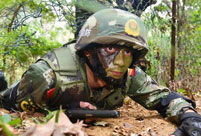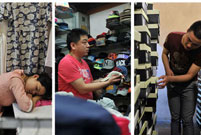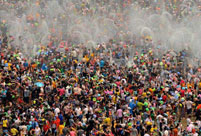 10 low-carbon tips to save money
10 low-carbon tips to save money
 Luxury cars make Asia premiere at Auto China
Luxury cars make Asia premiere at Auto China
 Versatile dog
Versatile dog
 Ni Ni covers BAZAAR JEWELRY
Ni Ni covers BAZAAR JEWELRY
 Cherry blossoms reach peak bloom in Washington D.C.
Cherry blossoms reach peak bloom in Washington D.C.
 Top Chinese fashion icons in foreigners' eyes
Top Chinese fashion icons in foreigners' eyes
 Asia's largest business aviation exhibition to be held in Shanghai
Asia's largest business aviation exhibition to be held in Shanghai
 World's top-rated luxury hotels
World's top-rated luxury hotels
 Wu Jing, Xie Nan to hold wedding on May
Wu Jing, Xie Nan to hold wedding on May
 London Cake International attracts tourists
London Cake International attracts tourists
JINDO, South Korea, April 23 -- Death toll in the South Korean ferry sinking accident continued to rise to 150 on Wednesday as hundreds of divers were searching inside the submerged vessel along guideline ropes amid favorable weather conditions.
As of 11 a.m. local time, 146 people have been confirmed dead, leaving 156 others still missing. The eighth day into search, the number of those rescued was unchanged at 174.
Four more bodies have been found since, raising the total death toll to 150. The search operation was suspended in the afternoon as tidal currents became faster. It will be resumed later when the currents turn slower.
Waters off Jindo Island, where the 6,825-ton ferry Sewol capsized and sank, are famous for the country's second-fastest currents.
Search operations repeated a suspension and resumption overnight as tidal currents became faster than forecast, but divers actively entered the sunken vessel in the morning.
Weather forecast said that the currents will slow down for four days through Thursday. Water temperature was at around 11-12 degrees Celsius in the morning, with waves being as high as 0.5 meters.
It was forecast to rain from Saturday, with the tidal currents expected to become faster, according to the weather forecast. Relatives of the victims have demanded divers pull bodies out of the vessel as late as Thursday to prevent corpses from decomposing further.
On Wednesday alone, 29 bodies have been pulled out of the submerged hull as divers made an intensive search operation into passenger cabins on the third and fourth floors of the five-story vessel.
Koh Myung-seok, director general of the South Korean coast guard, told a press briefing that lots of bodies were found on the fourth-floor cabins on the stern side, noting that divers were focusing on the fourth-floor cabins.
Koh said that the stern side on the fourth floor was swarmed with cabins which can accommodate 30-50 people, noting divers were also searching the third-floor passenger compartments.
Divers succeeded in entering the dining room and the lounge, where many teenagers were believed to have been trapped, but there was no body discovered in the dining room, said Koh.
The vessel carried 476 passengers, including 325 Danwon High School students and 14 teachers, when it capsized on April 16.
The search operation began to gather steam from Monday thanks to favorable weather conditions and guideline ropes with 36 bodies found Tuesday and 28 retrieved Monday respectively.
Five ropes were installed Sunday to guide divers against rapid currents into the sunken ferry, enabling divers to enter the hull at a faster pace than before. Two ropes were installed on the bow side, with two on the stern side and one in the middle of the ship. Five to six ropes were planned to be snaked into the hull.
Divers entered inside the hull along their respective guideline ropes simultaneously, resulting in random discovery and retrieval of bodies trapped inside the ship.
Inside the ship, divers faced many obstacles such as murky waters, intertwined junks and thick walls on which a hole should be made to enable the divers to enter the cabins, a South Korean navy official said.
The vessel was submerged while tilting at some 90 degrees to the surface, so divers were unable to move along hallways and aisles and enter the cabins through gates, the official said.
About 550 coast guard, navy and private divers were searching the submerged vessel, while 212 rescue ships and 34 airplanes were scouring the waters.
Ships and airplanes were searching for possible bodies floating away from the ship. Most ships were searching all the waters within a 1km radius, while draggers were trawling the waters outside the range.
Rescue efforts were aided by unmanned submersibles called remotely-operated vehicle (ROV). They were used to search the hull where divers were unable to enter. Salvage barges were deployed near the sunken vessel to allow divers to take a rest and plunge again into the waters.
Ships were deployed to clean up the waters as oil leaked out of the ship on Saturday. Jigging fishing boats, which catch squids, assisted in overnight search to offer lighting for nighttime operations.
 Commando elite specializes in sign language
Commando elite specializes in sign language Man photoshops himself into girlfriend's childhood photos
Man photoshops himself into girlfriend's childhood photos Photo story: Stallholders at Beijing Zoo Wholesale Market
Photo story: Stallholders at Beijing Zoo Wholesale Market Artists on backstage
Artists on backstage Beckham launches fund to support youth soccer in China
Beckham launches fund to support youth soccer in China Cherry blossoms hit peak bloom in Washington D.C.
Cherry blossoms hit peak bloom in Washington D.C. Children in ancient costumes learn Zhusuan
Children in ancient costumes learn Zhusuan Tens of thousands celebrate Water Splashing Festival
Tens of thousands celebrate Water Splashing Festival A bite of China II whets the appetite
A bite of China II whets the appetite Richest Chinese of 2014: half from the mainland
Richest Chinese of 2014: half from the mainland Chengdu - laid-back lifestyle makes happiest city
Chengdu - laid-back lifestyle makes happiest city The backstage of the Fashion Week
The backstage of the Fashion Week College students in Han costumes
College students in Han costumes Postgraduate works as waitress
Postgraduate works as waitress Life in a Lahu village in Yunnan
Life in a Lahu village in YunnanDay|Week|Month